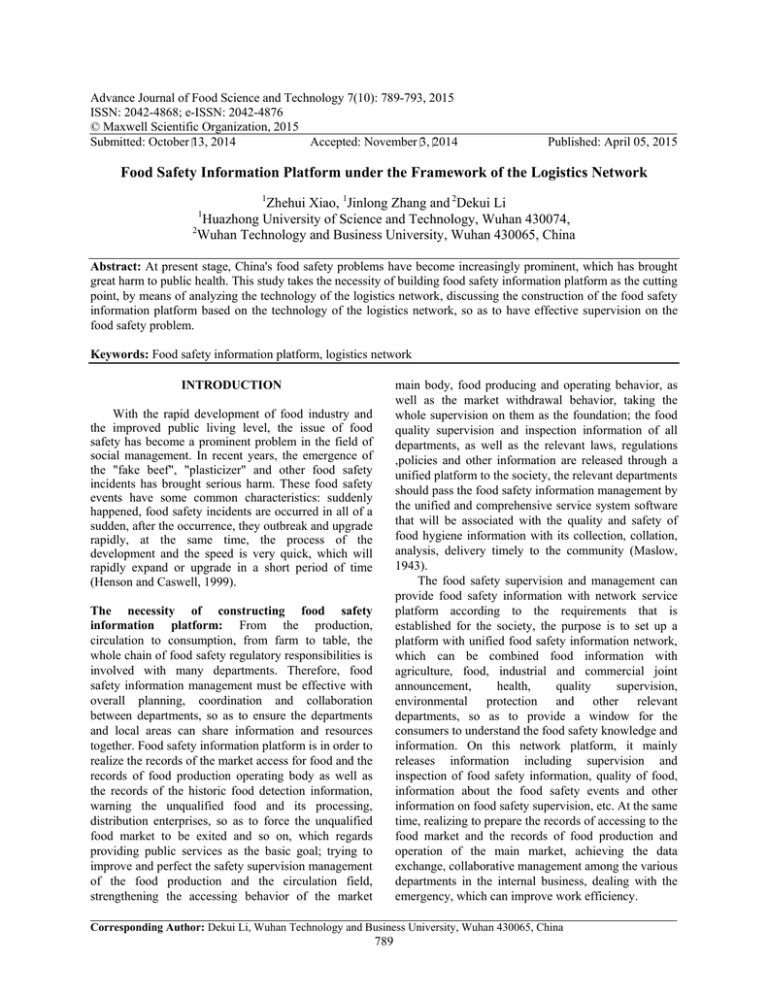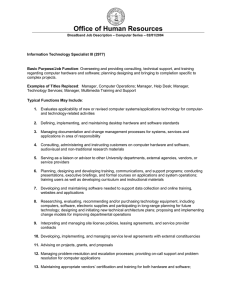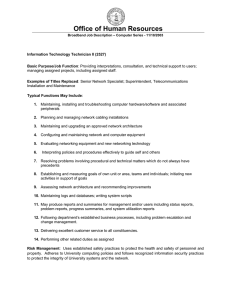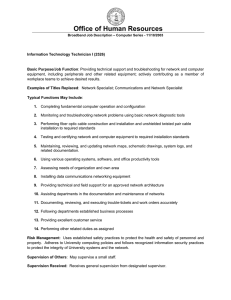Advance Journal of Food Science and Technology 7(10): 789-793, 2015
advertisement

Advance Journal of Food Science and Technology 7(10): 789-793, 2015 ISSN: 2042-4868; e-ISSN: 2042-4876 © Maxwell Scientific Organization, 2015 Submitted: October 13, 2014 Accepted: November 3, 2014 Published: April 05, 2015 Food Safety Information Platform under the Framework of the Logistics Network 1 Zhehui Xiao, 1Jinlong Zhang and 2Dekui Li Huazhong University of Science and Technology, Wuhan 430074, 2 Wuhan Technology and Business University, Wuhan 430065, China 1 Abstract: At present stage, China's food safety problems have become increasingly prominent, which has brought great harm to public health. This study takes the necessity of building food safety information platform as the cutting point, by means of analyzing the technology of the logistics network, discussing the construction of the food safety information platform based on the technology of the logistics network, so as to have effective supervision on the food safety problem. Keywords: Food safety information platform, logistics network main body, food producing and operating behavior, as well as the market withdrawal behavior, taking the whole supervision on them as the foundation; the food quality supervision and inspection information of all departments, as well as the relevant laws, regulations ,policies and other information are released through a unified platform to the society, the relevant departments should pass the food safety information management by the unified and comprehensive service system software that will be associated with the quality and safety of food hygiene information with its collection, collation, analysis, delivery timely to the community (Maslow, 1943). The food safety supervision and management can provide food safety information with network service platform according to the requirements that is established for the society, the purpose is to set up a platform with unified food safety information network, which can be combined food information with agriculture, food, industrial and commercial joint announcement, health, quality supervision, environmental protection and other relevant departments, so as to provide a window for the consumers to understand the food safety knowledge and information. On this network platform, it mainly releases information including supervision and inspection of food safety information, quality of food, information about the food safety events and other information on food safety supervision, etc. At the same time, realizing to prepare the records of accessing to the food market and the records of food production and operation of the main market, achieving the data exchange, collaborative management among the various departments in the internal business, dealing with the emergency, which can improve work efficiency. INTRODUCTION With the rapid development of food industry and the improved public living level, the issue of food safety has become a prominent problem in the field of social management. In recent years, the emergence of the "fake beef", "plasticizer" and other food safety incidents has brought serious harm. These food safety events have some common characteristics: suddenly happened, food safety incidents are occurred in all of a sudden, after the occurrence, they outbreak and upgrade rapidly, at the same time, the process of the development and the speed is very quick, which will rapidly expand or upgrade in a short period of time (Henson and Caswell, 1999). The necessity of constructing food safety information platform: From the production, circulation to consumption, from farm to table, the whole chain of food safety regulatory responsibilities is involved with many departments. Therefore, food safety information management must be effective with overall planning, coordination and collaboration between departments, so as to ensure the departments and local areas can share information and resources together. Food safety information platform is in order to realize the records of the market access for food and the records of food production operating body as well as the records of the historic food detection information, warning the unqualified food and its processing, distribution enterprises, so as to force the unqualified food market to be exited and so on, which regards providing public services as the basic goal; trying to improve and perfect the safety supervision management of the food production and the circulation field, strengthening the accessing behavior of the market Corresponding Author: Dekui Li, Wuhan Technology and Business University, Wuhan 430065, China 789 Adv. J. Food Sci. Technol., 7(10): 789-793, 2015 THE OVERVIEW OF INTERNET OF THINGS TECHNOLOGY The system architecture of internet of things: Internet of Things is based on the global network of EPC as the foundation, combined with some knowledge of the Internet of things, which provides us the structure diagram of the Internet of things system model shown in Fig. 1. This model includes the four parts of the Internet of things, namely the distribution of the underlying network, convergence gateway access, the integration of Internet and the application of terminal subscriber. In Fig. 2, there is lots of underlying network systems distributed in the physical space, according to their own characteristics to form and constitute the corresponding distribution of the network. The underlying network through RFID (Radio Frequency Identification), WSNs (Wireless Sensor Networks), wireless LAN network and other technologies to collect and acquire information and transfer them to intelligence gathering gateways, through the intelligent aggregation gateway to the integration system of the network, finally it can use broadcast and television network, Internet, telecommunication network and other network approaches to get information for the application system of the terminal subscriber. At the same time, the terminal subscribers can influence the underlying network through the subjective behaviors on The definition of internet of things technology: Internet of Things (IOT) is a huge network through various information sensor devices, such as Radio Frequency Identification (RFID), infrared sensors, global position system, laser scanners and other information sensor devices, according to the agreement to connect any items with the Internet, so as to form a system. Then we can exchange information and communicate to realize the intelligent identification, location, tracking, monitoring and management. In the Internet of things "object" has a logo, with physical properties as well as the essence of personality, which can use intelligent interface so as to realize the seamless integration with the information network. So the Internet of things can be widely used in national defense, production control, environmental monitoring, city management, transportation, medical education, public security, house life and some other fields. The Internet of things is also known as the third wave of global information industry following the computer, the Internet, which is a new round of market competition in information industry. Therefore, the study of the Internet of things is widespread concerned. Fig. 1: The system architecture of internet of things 790 Adv. J. Food Sci. Technol., 7(10): 789-793, 2015 Fig. 2: The structure of the system the different applications, so as to realize the information interaction of Internet of Things, especially between objects and people, objects and objects, objects and people. The distribution of the underlying network can be included WSNs, RFID system, wireless local area network, as well as the heterogeneous network, through the heterogeneous network communication, it can realize the perception of the object on the external physical environment, so as to allow the system to identify and collect information and capture the items. From the angle of the function of the network, the underlying network should have double functions of information acquisition and routing, at the same time, the underlying heterogeneous network also need to cooperate with each other to complete the specific task (Caswell, 2011). The main task of convergence 791 Adv. J. Food Sci. Technol., 7(10): 789-793, 2015 gateway access is to make the information acquired by the underlying network be smoothly accessed to the transmission network, the accessing technology including twisted pair, coaxial cable, accessing method of optical fiber cable and Bluetooth, WiMAX, WiFi, 4G, satellite communications and other wireless accessing modes. The intelligent convergence gateway usually has a strong ability of storage, processing and communication, the key of it is to realize the combination with the underlying network and realize the smooth integration with the network. The optimization of the network system includes radio and TV network, Internet and the integration of telecom network, which can mainly complete the long distance transmission of information. As for the application system of the terminal subscribers, it is mainly to complete the discovery and the function of the application of the related information. modular idea to have functional design for the platform, which is beneficial to the scalability and openness of the system in the future. It is as shown in Fig. 2. The platform can support consumers to query for their purchased food through the supermarket inquiry machine, intelligent mobile phone, Internet and other kinds of ways. After the consumers purchasing the food, they can query to the main information of the food in each circulation links through identification terminal of the RFID electronic tag, smart mobile phone or scanning and inputting the two-dimensional code of the food or bar code, etc., (Gao, 2009). The main information can be included: checking the registration of the production manufacturer, checking whether the food is from the formal channels, checking whether the food additives is exceeding over the standard, checking the production date and batch, checking whether the manufacturer is in the record of the administrative department for Industry and Commerce Department, etc. FOOD SAFETY INFORMATION PLATFORM BASED ON THE TECHNOLOGY OF THE LOGISTICS NETWORK The application service of the platform: The service function that is provided by the platform for the customer is mainly divided into the following four parts. The system of technology framework of food safety information platform: The platform system adopts the multilayer mode to support the system of technology framework, which can separate the hardware layer, access layer, data layer, function layer, service layer and application layer into several layers. The layers are as follows: the hardware layer is in the food circulation, each link has the installation with fixed or handheld RFID reader and back unit (raw material/additives/ packaging box) with RFID electronic label; in addition, it also offers smart mobile phone, wireless sensors, etc., as the hardware equipments. Access layer includes RFID data acquisition, filtering, encryption and data format conversion processing. The data layer includes database for business document, EPC-IS database, database of products. The service layer includes RFID event processing component, analysis and conversion components for XML business documents, data stream management, data exchanging service, Web service management, EPCIS service and other functions. The function layer includes the production of the food supplying chains, processing, transport, sales process tracking management. The application layer includes data warehouse, data mining, rules of knowledge and statistics analysis, etc. Information browsing: The related information browsing for food safety is a basic function of cloud platform, it can provide service for the customers with convenient, flexible, diverse forms of information, as well as the function of information retrieval and it can download information for the users and so on. In particular, based on the calcification of different latitude information about the object, the established region, character, brand, a specific event and so on, users can browse and have retrieval from different angles, download information, which also can undertake granularity scalability from different levels for browsing, searching and downloading information; based on the establishment of the index of food safety risk, information can be sorted in accordance with the level of risk, so as to establish the order of information, then users can focus on the key information; based on the consideration of timeliness of information, through focusing on today, users can sort information according to the time of the information to browse, search and download; during the process of browsing information, users can view and check the interested information the according to the development trend of the time, it can also be sent to the relevant personnel through the short message, email notification, so as to remind people and play its warning function. The system structure of food safety information platform: The Platform system is consisted of food safety information data center, food safety information supervision platform, the application system of food safety information. The system structure adopts the engineering standard component and the platform with Emergency early warning: It can provide the relevant information of the early warning event for the users; user can timely understand what kind of food safety incidents had happened in the world, so as to make 792 Adv. J. Food Sci. Technol., 7(10): 789-793, 2015 arrangements and prevention for the food safety management on the specific area in advance. the Internet and other channels, so as to realize the interaction between the public and food safety information network platform, realizing the maximum efficiency of food safety information platform. Statistical analysis: Statistical analysis is the third function provided by cloud platform. It can provide users with services of food safety early warning, statistics of food safety, displaying function, etc. Based on this, users can make statistical analysis on the information of food safety, from different angles, such as the objects and regions of food safety, combined with time, which can also be from different levels with time through size expansion to make statistical analysis. ACKNOWLEDGMENT This research study was funded by Collaborative Innovation Center for Modern Logistics and Business of Hubei (Cultivation). REFERENCES Report management: Report management is the forth function provided by cloud platform. During the process of browsing information, browsing the event as well as the process of making statistical analysis, users can conduct the "join the report" action to the specific interested contents, during the report management process, users can generate the corresponding reports, which is one of ways to generate a report; in addition, users can choose to customize the mode, which can determine the condition to be included in the report, namely it can add the suitable conditions into the report automatically (Laura and Charlotte, 2000). Since food safety issues have become increasingly prominent, the construction of food safety information platform can share information of food safety through Caswell, J.A., 2011. Economics of Food Safety. Elsevier Science Publishing Co., New York, pp: 23-26. Gao, Y., 2009. The state, problem and countermeasures of Chinese food security. Chinese Food Nutr., 143: 15-17. Henson, S. and J. Caswell, 1999. Food safety regulation: An overview of contemporary issues. Food Policy, 24: 589-603. Laura, M. and V. Charlotte, 2000. Rerulation and Market Beyond. Dartmouth and Ashgate, pp: 348-349. Maslow, A.H., 1943. A theory of human motivation. Psychol. Rev., 50: 370-396. 793



